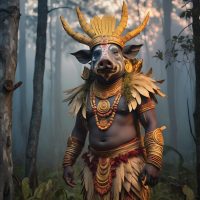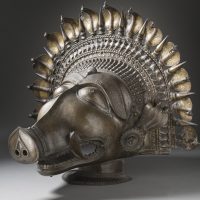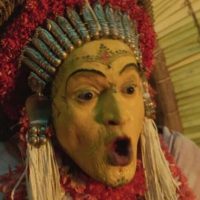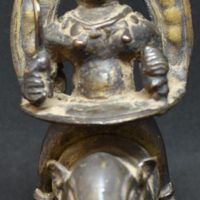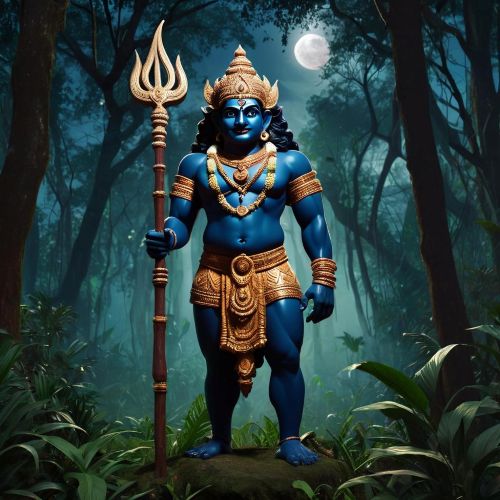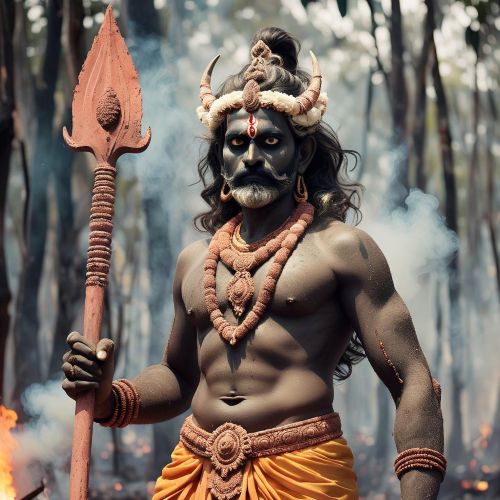Panjurli : The Boar Faced Guardian
Listen
At a glance
| Description | |
|---|---|
| Origin | Indian Mythology |
| Classification | Spirits |
| Family Members | N/A |
| Region | India |
| Associated With | Protection, Villages, Shamanistic Rituals |
Panjurli
Introduction
Panjurli is one of the most important guardian spirits of Tulunadu, the coastal region of Karnataka in southern India. Worshipped within the Bhuta Kola tradition, Panjurli is not a conventional Hindu deity but a Daiva, a divine spirit that bridges the human world and the supernatural. His worship stretches back centuries, rooted in the agricultural lives of the Tulu-speaking people. Farmers once feared wild boars for the destruction they caused to crops, yet they also revered their power and ferocity. Over time, this respect transformed into ritual devotion, and Panjurli emerged as the divine protector of land, cattle, and forests. His mythology represents a blend of animistic traditions with Hindu elements, reflecting the layered spiritual culture of South India. The 2022 film Kantara brought Panjurli into mainstream awareness, highlighting his role as both a divine judge and guardian of nature.
Physical Traits
The defining feature of Panjurli is his boar face, a striking symbol of untamed power. Sculptures, masks, and ritual costumes portray him with fierce tusks, thick eyebrows, and an imposing presence that embodies both ferocity and divinity. During Bhuta Kola, impersonators transform into Panjurli through elaborate attire, including towering headdresses often decorated with serpent motifs, colorful fabrics, heavy jewelry, and painted designs that convey both majesty and menace. This visual transformation is not simply performance; devotees believe the spirit enters the body of the impersonator, turning him into Panjurli himself. The anthropomorphic representation – with a human body and a boar’s visage – captures the tension between civilization and wilderness, reminding worshippers of nature’s raw strength and the necessity of respecting it.
Family
Legends about Panjurli’s origins vary, but all stress his divine connection. According to one widespread oral narrative, a wild boar wandered into the celestial gardens of Shiva and Parvati. When it was killed, its piglet survived. Moved by compassion, Parvati adopted the orphan, but its mischievous behavior created discord, leading Shiva to exile it to Earth. Transformed into a guardian spirit, the boar-child became Panjurli, tasked with protecting humanity and ensuring justice. Other traditions connect him to the Varaha avatar of Vishnu, associating him with cosmic balance. Panjurli is often paired with Guliga, another powerful Daiva, and together they represent complementary forces – one forgiving and compassionate, the other strict and unyielding. These relationships highlight his place in a wider spiritual family that straddles both folk religion and Hindu mythology.
Other names
Over centuries, Panjurli acquired multiple forms and titles that reflect his regional significance. In some places, he is called Panjurli Daiva, emphasizing his identity as a divine guardian. Texts and songs sometimes refer to him as Shiva Shambhootha, linking him directly to the household of Lord Shiva. Local variations of Panjurli are named after the villages or areas they protect, such as Annappa Panjurli, Kuppettu Panjurli, and Bolada Panjurli. These names mark his role as a kshetrapala, or guardian of sacred lands and agricultural spaces. In certain traditions, he is also identified with the boar incarnation of Vishnu, blurring the line between folk spirit and pan-Hindu god. The variety of names and forms demonstrates how Panjurli has been shaped by local traditions, geography, and evolving religious narratives.
Powers and Abilities
The powers of Panjurli are deeply tied to his role as a protector of villages and agricultural communities. He is believed to guard farmlands against wild animals, especially boars, and prevent natural calamities from destroying crops. His blessings ensure prosperity, fertility, and the well-being of both people and livestock. More than a provider, Panjurli is also a dispenser of justice. During Bhuta Kola rituals, he speaks through possessed oracles, resolving disputes, punishing dishonesty, and offering guidance. Oral traditions describe him blinding priests who disrespected him, making animals vanish, or inflicting misfortune on those who neglected his worship. Yet, Panjurli is not seen as cruel; he is remembered for fairness and mercy, forgiving those who seek reconciliation. His power embodies the balance between fear and protection, teaching communities to respect natural law and moral order.
Modern Day Influence
Panjurli remains a living spirit, not just a figure of ancient folklore. In Tulunadu, annual Bhuta Kola rituals continue to attract thousands, where the transformation of human performers into Panjurli is seen as a sacred event that renews the bond between people, land, and divinity. Beyond the region, his presence in popular culture has grown dramatically since the release of Kantara. The film’s vivid portrayal of Panjurli’s mythology introduced him to national and international audiences, sparking renewed curiosity about the Bhuta Kola tradition. Artists, writers, and filmmakers now explore his story as a symbol of justice, ecological harmony, and indigenous spirituality. Museums display masks and costumes used in Panjurli rituals, and academic studies highlight his role in shaping the cultural identity of coastal Karnataka. More recently, Panjurli has also been embraced in environmental discourse, as his mythology emphasizes living in balance with forests and wildlife. In this way, Panjurli transcends myth to become a reminder of how ancient traditions can guide modern conversations about sustainability and cultural preservation.
Related Images
Source
Kumar, K. H. (2024). Daiva: Discovering the Extraordinary World of Spirit Worship. HarperCollins India.
Rai, B. A. Viveka. (2010). Epics in the Oral Genre System of Tulunadu. Retrieved from https://tulu-research.blogspot.com/2010/03/233-panjurli.html
Pattanaik, D. (2021). Tulu-Nadu’s Bhootas. Retrieved from https://devdutt.com/tulu-nadus-bhootas/
Bronzes of India. (2018). Panjurli. Retrieved from https://bronzesofindia.com/panjurli/
Hindu Devotional Blog. (2023). Panjurli wild boar with powerful divine spirit. Retrieved from https://www.hindudevotionalblog.com/2023/12/panjurli-wild-boar-with-powerful-divine.html
Peepul Tree. (2024). Guliga and Panjurli – The Divine Deities from Kantara. Retrieved from https://www.peepultree.world/livehistoryindia/story/living-culture/the-divine-deities-from-kantara
Swaraymag. (2025). Where The Spirits Speak: A Journey into The Daiva Traditions of Tulu Nadu. Retrieved from https://swarajyamag.com/culture/where-the-spirits-speak-a-journey-into-the-daiva-traditions-of-tulu-nadu
Spooklorepedia. (2024). Legend of Panjurli: The Divine Boar Spirit of Tulu Folklore. Retrieved from https://spooklorepedia.com/vault/gods-among-us/panjurli-kantara/
Hinduism Facts. (2025, April 8). Panjurli and Guliga – The Gods From Kantara. Retrieved from https://hinduismfacts.org/panjurli/
Tomar, N. (2025, October 2). Kantara’s Gods are Real: The untold myth of Panjurli and Gulega from Coastal Karnataka. Moneycontrol. Retrieved from https://www.moneycontrol.com/entertainment/regional/kantara-s-gods-are-real-the-untold-myth-of-panjurli-and-gulega-from-coastal-karnataka-article-13594161.html
Wikipedia contributors. (2025). Buta Kola. Wikipedia. Retrieved from https://en.wikipedia.org/wiki/Buta_Kola
Upadhyaya, U. (2019). Bhuta Worship in Tulunadu: A Study of Ritual and Belief. Journal of South Indian Folklore, 15(2), 45–62.
Rao, S. (2017). Spirit Cults of Coastal Karnataka. Mysore University Press.
Shetty, R. (2022). Kantara [Film]. Hombale Films.
Bhat, N. (2015). Daiva Worship and Agrarian Culture in Tulunadu. Karnataka Historical Review, 22(1), 88–103.
Nayak, M. (2020). The Sacred and the Wild: Ecology in Bhuta Kola Traditions. Indian Journal of Cultural Studies, 11(3), 112–129.
Frequently Asked Questions
What is lorem Ipsum?
I am text block. Click edit button to change this text. Lorem ipsum dolor sit amet, consectetur adipiscing elit. Ut elit tellus, luctus nec ullamcorper mattis, pulvinar dapibus leo.
What is lorem Ipsum?
I am text block. Click edit button to change this text. Lorem ipsum dolor sit amet, consectetur adipiscing elit. Ut elit tellus, luctus nec ullamcorper mattis, pulvinar dapibus leo.
What is lorem Ipsum?
I am text block. Click edit button to change this text. Lorem ipsum dolor sit amet, consectetur adipiscing elit. Ut elit tellus, luctus nec ullamcorper mattis, pulvinar dapibus leo.
What is lorem Ipsum?
I am text block. Click edit button to change this text. Lorem ipsum dolor sit amet, consectetur adipiscing elit. Ut elit tellus, luctus nec ullamcorper mattis, pulvinar dapibus leo.
What is lorem Ipsum?
I am text block. Click edit button to change this text. Lorem ipsum dolor sit amet, consectetur adipiscing elit. Ut elit tellus, luctus nec ullamcorper mattis, pulvinar dapibus leo.


